A sunglint has turned the waters off the Greek islands into a silver mirror, which was based on a photograph captured by an astronaut at the International Space Stations (ISS).
The image reportedly shows the Sun's light reflecting from the waters surrounding Greece with oceanographic effects only visible when a person is viewing from outer space.
Greek Islands Silver Mirror

An unidentified member of the ISS Expedition 67 crew caught the image on June 25 using only a digital camera directing out of an ISS window, according to Live Science.
The location of sunglint is between the Greek volcanic island of Milos and its paired Greek Island Antimilos.
The so-called silver sea due to the color-changing phenomenon include the Myrtoan Sea located Norwest of Milos and the Sea of Crete in the southwest, both of which are part of the larger Mediterranean Sea.
Also Read: Natural Sunlight Could Increase the Toxicity of Oil Spills to Wildlife
What is a Sunglint?
Sunglint is an optical phenomenon which occurs when sunlight reflects from a water's surface at the same angle relative to the satellite sensor viewing it.
This event results in a mirror-like reflection of sunlight off the water return back to the satellite or astronaut, according to the National Aeronautics and Space Administration (NASA).
One can frequently notice the phenomenon when looking at satellite imagery or astronaut photography, which contain bright patches of light, NASA added.
These sunlight particles can visually transform some bodies of water glow with an unusual color similar to a silver mirror.
Water Phenomenon
Related incidents in the past have transpired in multiple locations, including on the waters around Cape Cod and Lesser Antilles, as well as in the rivers of Brazil.
The US space agency also reported the occurrence of the water phenomenon off Crete and the Aegean Islands before.
Aside from sunlight itself, there are various factors that support the manifestation of the phenomenon, including wind patterns and atmospheric conditions.
Environmental Implications
Sunglint apparently has no ecological effect for marine species and their habitats.
Instead, it only highlights physical features of the water and the atmosphere above it from the point of view of the astronaut or satellite capturing it.
Other reported environmental implications of the phenomenon reside in the aspect of supporting scientific opportunities.
Specifically, it helps oil detection on the water surface, whether it takes the form of natural oil seeps or human-caused oil spills, NASA reports.
Deepwater Horizon Disaster
Following the Deepwater Horizon disaster in April 2010, the National Oceanic and Atmospheric Administration (NOAA) in May of that year reported that NASA's Aqua satellite observed sunglint on Gulf oil slick.
This is according to NASA's Goddard Space Flight Center, which said that the May 18 NOAA update showed the main bulk of the oil spill is dozens of miles away from the Loop Current, as cited by Phys.org.
The spill was captured by satellite imagery on May 17, producing visual data which purportedly helped maritime authorities to contain the worst human-caused oil spill in recorded history.
Related Article: Strange Light Flashes Spotted on Earth From Space Finally Explained
© 2025 NatureWorldNews.com All rights reserved. Do not reproduce without permission.





